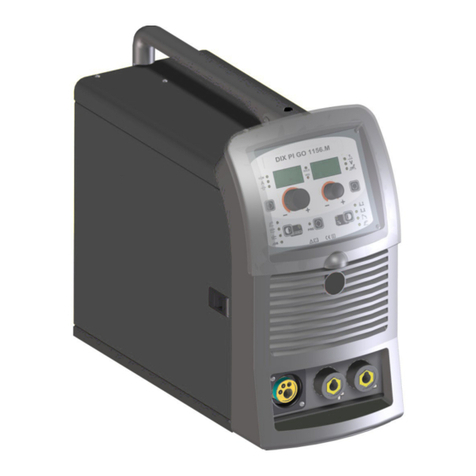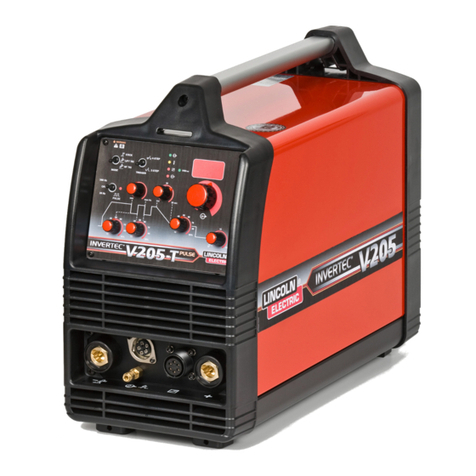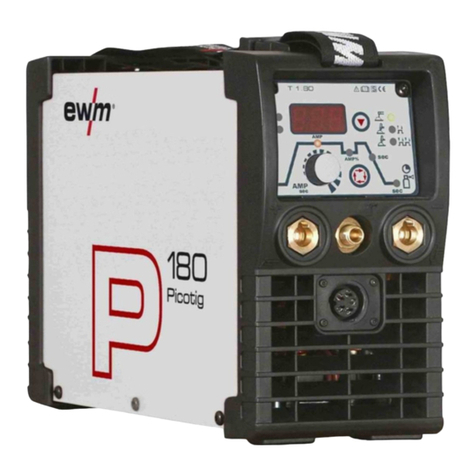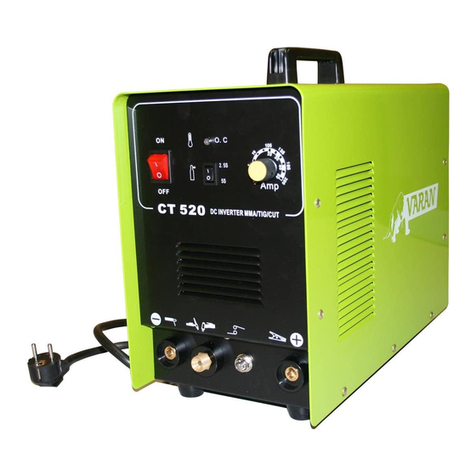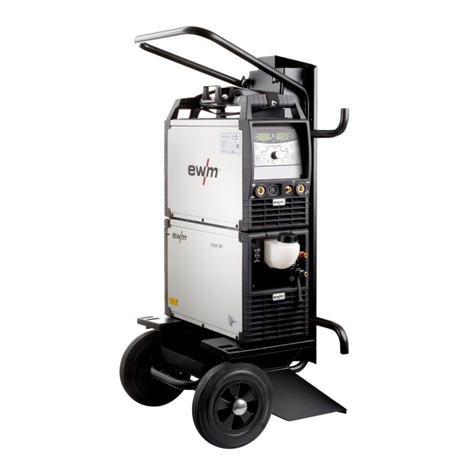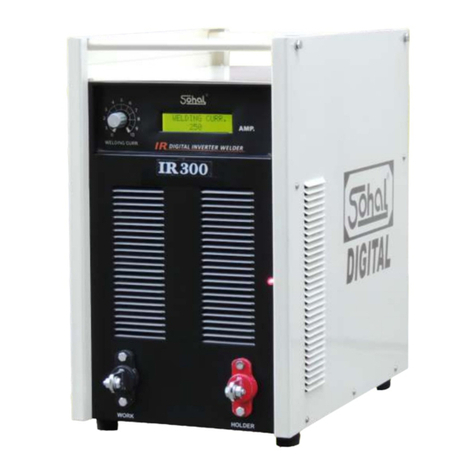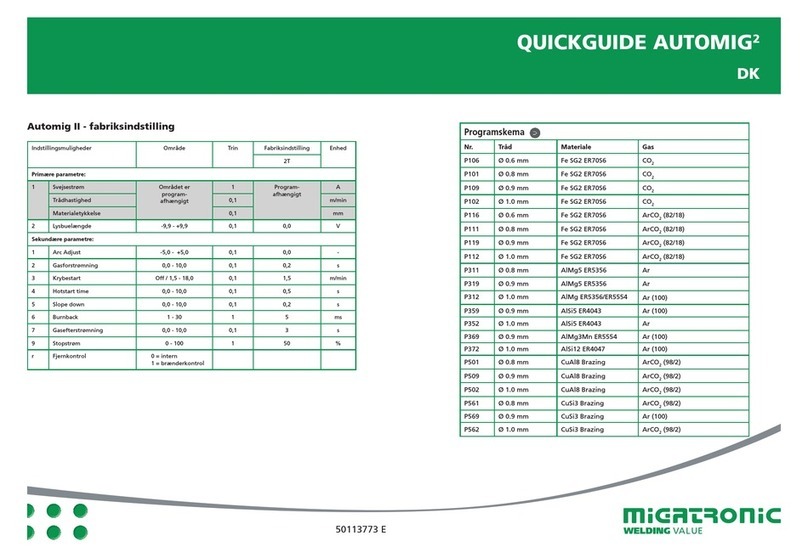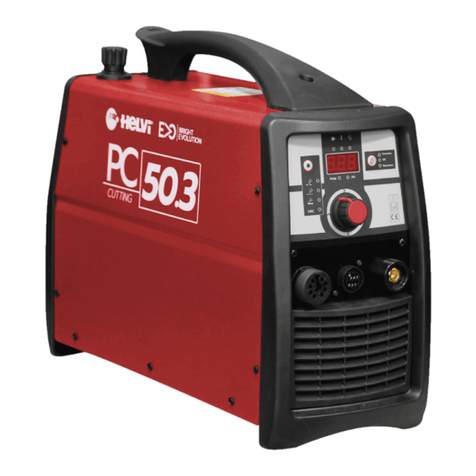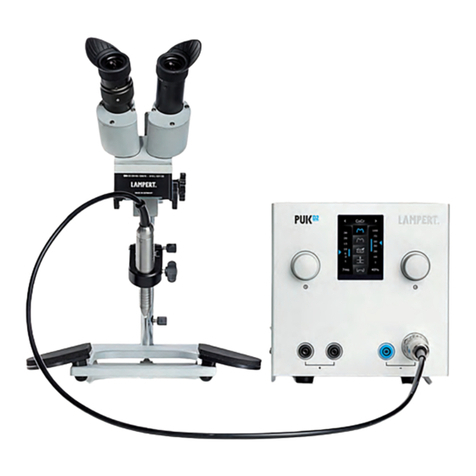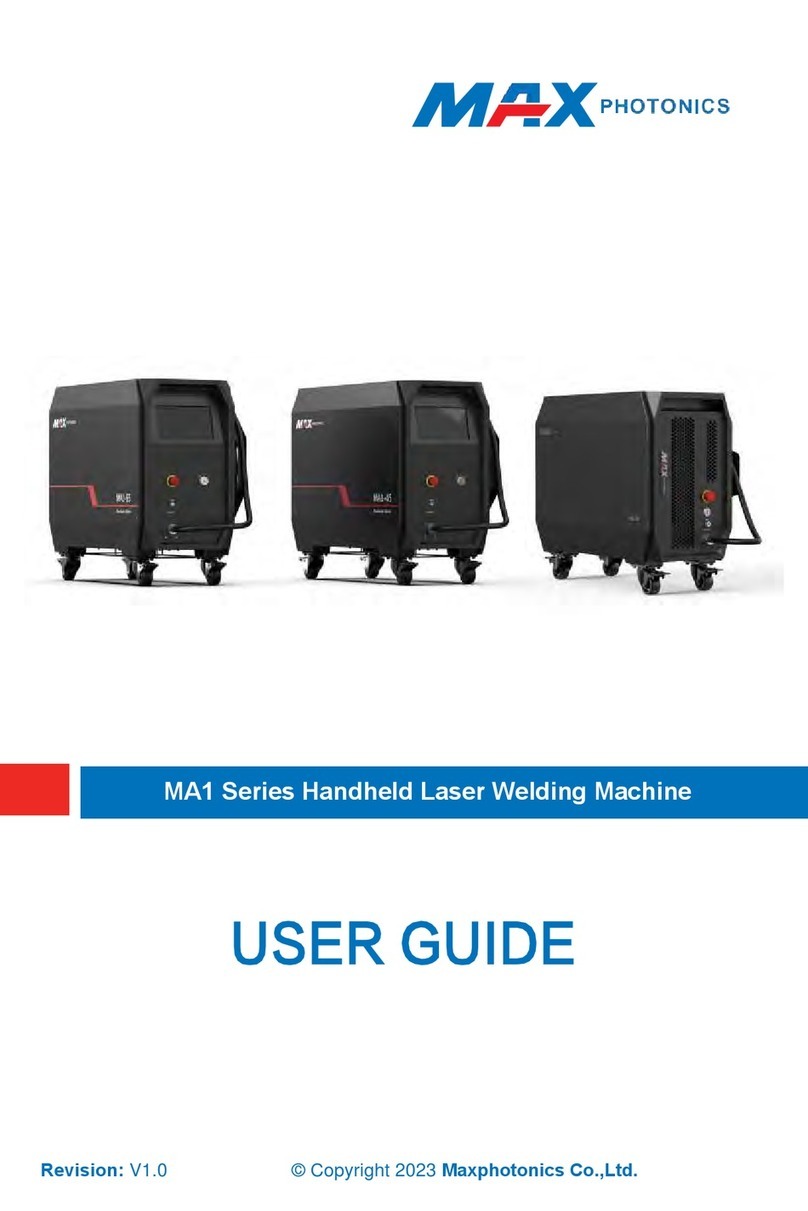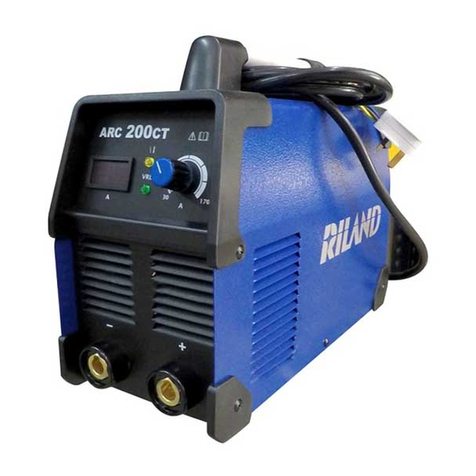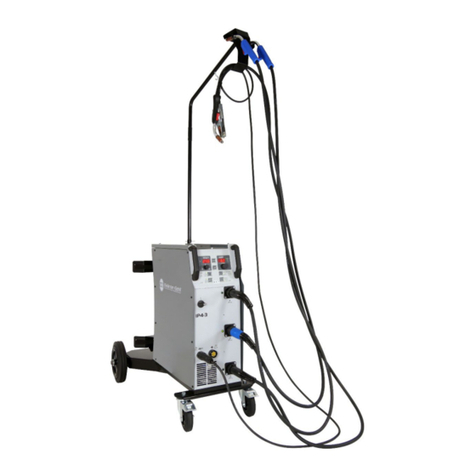DINSE DIX PI 3006.M I Puls User manual

BA-0116
Welding Power Source
SCHWEISSEN WELDING WELDINGSCHWEISSEN SCHWEISSEN
Keepinsecureareaforfuturereference!
Operations manual
DIX PI 3006.M I
DIX PI 3506.M I
DIX PI 3006.M I Puls
DIX PI 3506.M I Puls

2
Introduction
Thank you for buying our product.
In order to get the best performance out of the plant and ensure
the maximum lifespan of its parts, the use and maintenance
instructions contained in this manual must be read and strictly
complied with, as well as the safety instructions contained
in the relevant folder. If repairs to the plant are required, we
recommend that our clients contact our service centre work-
shops, as they have the necessary equipment and personnel
that are specifically trained and constantly updated.
All our welding power sources and equipment are constantly
developed and so changes may be made in terms of their con-
struction and features.
Description
MULTI-FUNCTION INVERTER WELDING POWER SOURCE
FOR MIG-MAG, MMA, and TIG WELDING
The series of multi-function equipments are characterised by
cutting edge, attractive design combined with latest genera-
tion inverter technology and digital welding control. Innovative,
technologically advanced, robust, and easy to use, they can
be used for very high quality MIG-MAG and Puls MIG welding
for all materials and especially stainless steel and aluminium,
reducing repeat work due to spray to a minimum, using elec-
trodes, and in TIG with “Lift” type ignition, and they represent
the best solution for all industrial fields and all specialist weld-
ing purposes that call for high precision and repeatable results.
DIX PI 3506.M I / DIX PI 3006.M I Puls / DIX PI 3506.M I Puls
equipments, fitted with the extraordinary DIX.ARC meet the
needs of those that wish to combine synergy with complete
control of all welding parameters.
These are systems open to the future evolution of technology -
the control software can be kept up to date with the latest ver-
sions with the help of a personal computer.
Operating features
The main feature of the welding unit
DIX PI 3006.M I / DIX PI 3506.M I / DIX PI 3006.M I Puls /
DIX PI 3506.M I Puls are:
• Metallic main structure with shockproof plastic front frame.
• Controls protected by a visor.
•
Exceptional characteristics for MIG-MAG, MMA, and TIG
welding with “Lift” type ignition.
•
Synergic digital control of all welding parameters, with the
following functions:
-
Allows less expert operators to regulate all welding param-
eters in a user-friendly way and extremely easily, choos-
ing the type of program on the basis of the material, wire
diameter, and gas used.
-
Innovative “DIX ARC” software for controlling all welding
parameters.
- BURN BACK control.At the end of each weld, in any con-
dition and with any material, the digital control ensures a
perfect wire cut, prevents the typical “wire globule” from
forming and ensures correct arc restriking.
-
WSC Wire start control. This arc striking control device pre-
vents wire from sticking to the workpiece or torch nozzle
and ensures precise and smooth arc striking, particularly
when welding aluminium.
-
Welding parameters that are controlled digitally by a mi-
croprocessor, are monitored and modified in just a few mi-
croseconds, maintaining a consistently precise and stable
arc as the welding conditions continue to vary due to the
movement of the torch and the irregularities of the parts
to be welded.
Introduction 2
Description 2
Operating features 2
Technical data 3
Usage limits (IEC 60974-1) 3
How to lift up the system 4
Opening the packaging 4
Installation and connections 4
Connection to the electrical supply 4
Loading wire 5
Assembly of drive rollers 5
Control apparatus 5
MIG-MAG / Puls MIG / DOUBLE Puls MIG Welding 6
Spot welding 6
Interval welding (Stitch) 6
Aluminium welding 7
Electrode welding (MMA) 7
TIG welding with “Lift” 8
Maintenance 8
Optional 8
The pointing out of any difficulties and their elimination9
Replacing the digital interface PCB 9
Troubleshooting table 10
Meaning of graphic symbols on welding power
source 11
Wiring diagram 11
DINSE G.m.b.H.
Tarpen 36 • D-22419 Hamburg
Tel. +49 (0)40 658 75-0
Fax +49 (0)40 658 75-200
Copyright © 2018 DINSE G.m.b.H., Hamburg.
These instructions or excerpts there of shall not be duplicated, transla-
ted or reproduced, nor shall they be stored, processed, transmitted or
distributed by any electronic means without the prior written permission
of DINSE G.m.b.H.

3
- The SWS “Smart Welding Stop” system at the end of TIG
welding. Lifting up the torch without switching off the arc will
introduce a slope down and it will switch off automatically.
-
“Energy Saving” function to operate the power source cool-
ing fan and the torch water cooling only when necessary.
• High electrical performance resulting in a reduction in ener-
gy consumption.
•
Professional 4-roller wire feeder that guarantees precise and
constant feeding of the wire. This wire feeder’s principal char-
acteristics are:
-
Designed for use with all types of solid and core type wire.
- A24 V direct current ratio motor.
- Agas solenoid valve.
- Wire speed (welding current) and welding voltage adjust-
ment.
- Graduated knobs for precise adjustment of the wire pres-
sure that stays unvaried when the arms open and close.
-
The feeder rollers can be replaced without using any tools.
Technical data
The general technical data of the system are summarized in
table 1.
Usage limits (IEC 60974-1)
The use of a welder is typically discontinuous, in that it is made
up of effective work periods (welding) and rest periods (for the
positioning of parts, the replacement of wire and underflushing
operations etc. This welder is dimensioned to supply a I2max
nominal current in complete safety for a period of work of 40%
of the total usage time. The regulations in force establish the
total usage time to be 10 minutes. The work cycle is consid-
ered to be 40% of this period of time. Exceeding the work cy-
cle allowed could cause a trip switch to trip, which protects the
components inside the welding welding power source against
dangerous overheating.After several minutes the overheat cut-
off rearms automatically and the welder is ready for use again.
Table 1
Model DIX PI 3006.M I DIX PI 3506.M I DIX PI 3006.M I Puls DIX PI 3506.M I Puls
MIG/MAG welding
Three-phase input 50/60 Hz V400 ± 20% 400 ± 20% 400 ± 20% 400 ± 20%
Mains supply: Zmax Ω0,037 0,028 0,037 0,028
Input power @ I2Max kVA 13 17,8 17 23,7
Delayed fuse (Ieff) A20 20 25 25
Power factor / cosφ 0,87/0,99 0,92 / 0,99 0,66 / 0,99 0,70 / 0,99
Efficiency degree η0,86 0,85 0,86 0,85
Open circuit voltage V63 63 63 63
Current range A10 ÷ 320 10 ÷ 400 10 ÷ 320 10 ÷ 400
Duty cycle @ 100% (40°C) A280 300 280 300
Duty cycle @ 60% (40°C) A300 350 300 350
Duty cycle @ 40% (40°C) A320 400 320 400
Wires diameter mm 0,6 ÷ 1,2 0,6 ÷ 1,2 0,6 ÷ 1,2 0,6 ÷ 1,2
N° rollers 4444
Power output of feeder motor W50 50 50 50
Rated wire feeding speed m/min 0,5 ÷ 20 0,5 ÷ 20 0,5 ÷ 20 0,5 ÷ 20
Welding wire spool
Diameter
Weight mm
kg Ø300
15 Ø300
15 Ø300
15 Ø300
15
Standards IEC 60974-1
IEC 60974-5
IEC 60974-10
IEC 60974-1
IEC 60974-5
IEC 60974-10
IEC 60974-1
IEC 60974-5
IEC 60974-10
IEC 60974-1
IEC 60974-5
IEC 60974-10
Protection class IP 23 S IP 23 S IP 23 S IP 23 S
Insulation class HHHH
Dimensions mm 660 - 515 - 290 660 - 515 - 290 660 - 515 - 290 660 - 515 - 290
Weight kg 41 42 42 43
WARNING: This equipment complies with EN//IEC 61000-3-12 provided that the maximum permissible system impedance Zmax is less than
or equal to 0,037 Ω at the interface point between the user’s supply and the public system. It is the responsibility of the installer or user of the
equipment to ensure, by consultation with the distribution network operator if necessary, that the equipment is connected only to a supply with
maximum permissible system impedance Zmax less than or equal to 0,037 Ω.
This system, tested according to EN/IEC 61000-3-3, meets the requirements of EN/IEC 61000-3-11.

4
How to lift up the system
Strap the system safely and securely in the slings working from
the bottom, then lift up from the ground.
This welding welding power source has a robust handle built
into the frame for moving the equipment.
NOTE: These hoisting and transportation devices conform to
European standards. Do not use other hoisting and transpor-
tation systems.
Opening the packaging
The system essentially consists of:
•
DIX PI 3506.M I / DIX PI 3006.M I Puls / DIX PI 3506.M I
Puls weld unit.
• Separately:
- MIG-MAG welding torch (optional).
- Coolant unit for welding torch (optional).
- Trolley to carry it around (optional).
Perform the following operations on receiving the apparatus:
• Remove the welding power source and all accessories and
components from the packaging.
•
Check that the welding apparatus is in good condition; other-
wise immediately inform the retailer or distributor.
• Check that all the ventilation grilles are open and that there
is nothing to obstruct the correct air flow.
Installation and connections
The installation site for the system must be carefully chosen
in order to ensure its satisfactory and safe use. The user is re-
sponsible for the installation and use of the system in accord-
ance with the producer’s instructions contained in this manual.
Before installing the system the user must take into consider-
ation the potential electromagnetic problems in the work area.
In particular, we suggest that you should avoid installing the
system close to:
• Signalling, control and telephone cables.
• Radio and television transmitters and receivers.
• Computers and control and measurement instruments.
• Security and protection instruments.
Persons fitted with pace-makers, hearing aids and similar
equipment must consult their doctor before going near a weld-
ing power source in operation. The equipment’s installation
environment must comply to the protection level of the frame.
The welding unit is characterized by the following classes:
•
IP 23 S protection class indicates that the welding power
source can be used in both interior and exterior environ-
ments.
•
The “S” usage class indicates that the welding power source
can be employed in environments with a high risk of electri-
cal shocks.
This system is cooled by means of the forced circulation of air,
and must therefore be placed in such a way that the air may
be easily sucked in and expelled through the apertures made
in the frame.
Assemble the system in the following way:
• Assemble the trolley.
• Fixing the cooling unit to the trolley.
•
Fixing of the welding welding power source to the trolley and
the cooling unit (electrical and plumbing connections).
• Connect up the welder to the mains.
• Connect up the welding cables.
Instructions for fitting the individual components / optional ex-
tras are contained in the relevant packaging.
Connection to the electrical supply
Connection of the welding power source to the user line
(electrical current) must be performed by qualified per-
sonnel.
Before connecting the welding welding power source to
the mains power supply, make sure that rated voltage and
frequency correspond to those provided by the mains pow-
er supply and that the welding welding power source’s
power switch is turned to “O”.
Use the welder’s own plug to connect it up to the main pow-
er supply. Proceed as follows if you have to replace the plug:
•
3 conducting wires are needed for connecting the welding
power source to the supply.
•
The fourth, which is YELLOW GREEN in colour is used for
making the “GROUND” connection.
Before connecting the welding welding power source to
the mains power supply, make sure that rated voltage and
frequency correspond to those provided by the mains pow-
er supply and that the welding welding power source’s
power switch is turned to “O”.
Table 2 shows the capacity values that are recommended for
fuses in the line with delays.
NOTE: Any extensions to the power cable must be of a suita-
ble diameter, and absolutely not of a smaller diameter than the
special cable supplied with the welding power source.
Table 2
Model DIX PI 3006.M I DIX PI 3506.M I DIX PI 3006.M I Puls DIX PI 3506.M I Puls
MIG-MAG welding
Input power @ I2Max kVA 13 17,8 17 23,7
Delayed fuse (Ieff) A16 20 25 25
Nominal current @ 40% duty cycle (40°C) A320 400 320 400
Mains cable
Length
Cross section m
mm24
4 × 2,5 4,5
4 × 4 4
4 × 2,5 4,5
4 × 4
Ground cable cross section mm250 50 50 50

5
Loading wire
•
Fit the reel (diam. 300 mm) on the support so that the wire
unrolls clockwise, and center the projecting reference on the
support with the relative hold on the reel.
•
Thread the end of the wire into the back guide (Pos. 1, Fig.A)
on the drawing mechanism.
•
Lift up the idle rolls (Pos. 4, Fig. A) releasing the roll pres-
sure device (Pos. 2, Fig. A). Make sure that the drive rolls
(Pos. 7, Fig.A) have the diameter corresponding to the wire
being used stamped on the outside.
• Insert the wire into the central wire guide and the wire guide
on the centralised connection (Pos. 5, Fig. A) by a few cen-
timetres. Lower the idle roller holder arms, making sure that
the wire slots into the hollow in the motor’s roller. If neces-
sary, adjust the pressure between the rollers by turning the
relevant screw (Pos. 2, Fig. A). The correct pressure is the
minimum that does not allow the rollers to skid on the wire.
Excessive pressure will case deformation of the wire and tan-
gling on the entrance of the sheath; insufficient pressure can
cause irregular welding.
Assembly of drive rollers
Unscrew the two screws (Pos. 6, Fig. A). Lift up the idle roll-
holder arm (Pos. 3, Fig. A) and proceed as follows:
•
Each roller shows the type of wire and diameter on the two
external sides.
•
Install the right rolls (Pos. 7, Fig.A) making sure the groove is
in the correct position for the diameter of the wire being used.
Control apparatus
Fig. B
Pos. 1 Control panel.
Pos. 2 Centralized torch connection.
Pos. 3 Up/Down connector.
Pos. 4 Fast coupling positive polarity.
Pos. 5 Fast coupling negative polarity.
Pos. 6 Mains cable.
Pos. 7 Power supply switch. In the “O” position the welder
is off.
Pos. 8 Connector for connecting the cooling system.
FIG. B
77
6
5
2
3 4 4 3
2
1
6
FIG. A

6
2 - Welding
1) Switch the welding welding power source on by moving the
power supply switch to I (Pos. 6, Fig. B).
2) Make the adjustments and do the parameter settings on
the control panel.
3) Load the wire using the torch button, afterhaving removed
the wire guide nozzle from the torch to allow the wire to
come out freely, while loading (remember that the wire
guide nozzle must correspond to the diameter of the wire
used).
4) Open the tap on the cylinder slowly and adjust the reducer
knob to obtain a pressure of about 1,3 to 1,7 bar, and reg-
ulate the flow to a value between 14 and 20 lit/min to suit
the current used for welding.
5) The welding welding power source is ready to weld. Start
welding by moving close to the welding point and press the
torch button.
6) Once welding has been completed remove any slag, switch
off the welding power source (which is only to be done
when the fan is not running), and close the gas cylinder.
Spot welding
Welding can be done with or without gas.The substantial differ-
ence with MIG-MAG welding is essentially related to the torch
and the adjustments that must be made on the control panel.
• Depending on the torch chosen and the work to be done, a
gas guide nozzle can be fitted on the torch that is specifical-
ly for spot welding (see Fig. E).
• Use the control panel to select the spot-welding mode and,
if necessary, make the changes to the related “Special func-
tions - Fx”, which allows the welding power source to do this
specific type of welding.
To begin spot welding:
•
Place the gas guiding nozzle perpendicular on the workpiece
to be spot welded.
•
Press the torch button to start the welding current and wire
feed.
•
When the spot welding time expires (SPOT WELD TIME),
the wire feed stops automatically.
•
When the torch button is pushed again a new welding cy-
cle starts.
• Release the torch button.
FIG. D
Interval welding (Stitch)
The substantial differences with the spot welding mainly con-
cern the adjustments that must be carried on the welding weld-
ing power source.
Use the control panel to select the interval welding mode and
then make the changes to the related “Special functions - Fx”,
which allows the welding power source to do this specific type
of welding.
To begin interval welding:
•
Press the torch button to start the welding current and wire
feed.
•
At this point the welding welding power source automatically
carries out a succession of welded portions (STITCH WELD
TIME) followed by a pause (STITCH WELD PAUSE), accord-
ing to the times entered previously. This procedure stops au-
tomatically when the TORCH BUTTON is released.
•
When the torch button is pushed again the torch begins a
new interval welding cycle.
MIG-MAG / Puls MIG / DOUBLE
Puls MIG Welding
To begin MIG-MAG / Puls MIG / DOUBLE Puls MIG welding,
carry out the following tasks (with the welding power source
switched off).
1 - Connecting the cables (Fig. C)
•
Connect the gas hose to the pressure reducer fitted on the
cylinder beforehand.
• Screw the torch onto the centralised connection on the front
panel of the welding welding power source and connect the
feed (blue) and return (red) water hoses for cooling the torch
to the respective rapid couplings (coloured blue and red) on
the front panel of the cooling system.
• Connect up the earthing system cable to the rapid coupling
marked by a - (negative) symbol and then the relevant ground
clamps to the piece being welded or to its support in an area
free from rust, paint and grease. Using particularly long earth-
ing cables reduces the voltage and causes some problems
from increased resistance and inductance of the cables that
could cause faulty welding. Follow instructions to avoid these
problems:
-
Use earthing and extension cables with appropriate sec-
tion.
-
Lay out the cables as a flat as possible to prevent them
from coiling up.
FIG. C

7
Aluminium welding
To weld with aluminum wire proceed as follows:
• Replace the drive rolls with special ones for aluminium wire.
•
We recommend to use a torch set with a maximum lenght of
3 m and a capillary liner, e.g. DIX DSK 2-xx.
•
Set the pressure between the drive rollers at the minimum,
by turning the screw provided.
•
Use argon gas at a pressure of 1,3 - 1,7 bar and regulate
the flow to a value between 14 and 20 lit/min to suit the cur-
rent used for welding.
Electrode welding (MMA)
On the DIX PI 3506.M I / DIX PI 3006.M I Puls / DIX PI 3506.M
I Puls welding power source, electrode welding is used to weld
most metals (different types of steel, etc.) using coated rutilic
and basic electrodes with diameters ranging from Ø 1.6 mm to
Ø 6 mm, and devices that the user can adjust for “Arc Force”,
“Hot Start”, and Anti-sticking functions to avoid the electrodes
sticking.
1) Connecting the welding cables (Fig. E):
Disconnect the welding power source from the mains pow-
er supply and connect the welding cables to the output
terminals (Positive and Negative) of the welding welding
power source, attaching them to the clamp and ground
with the polarity specified for the type of electrode being
used (Fig.E). Always follow the electrode manufacturer’s
instructions. The welding cables must be as short as pos-
sible, they must be near to one another, positioned at or
near floor level. Do not touch the electrode clamp and the
ground clamp simultaneously.
2) Switch the welding welding power source on by moving the
power supply switch to I (Pos. 7, Fig. B).
3) Make the adjustments and do the parameter settings on
the control panel.
4) Carry out welding by moving the torch to the workpiece.
Strike the arc (press the electrode quickly against the met-
al and then lift it) to melt the electrode, the coating of which
forms a protective residue. Then continue welding at an in-
clination of about 60° compared with the metal in relation
to the direction of welding.
PART TO BE WELDED
The part to be welded must always be connected to ground
in order to reduce electromagnetic emission. Much attention
must be afforded so that the ground connection of the part to
be welded does not increase the risk of accident to the user or
the risk of damage to other electric equipment. When it is nec-
essary to connect the part to be welded to ground, you should
make a direct connection between the part and the ground
shaft. In those countries in which such a connection is not al-
lowed, connect the part to be welded to ground using suitable
capacitors, in compliance with the national regulations.
WELDING PARAMETERS
Table 3 shows some general indications for the choice of elec-
trode, based on the thickness of the parts to be welded. The
values of current to use are shown in the table with the respec-
tive electrodes for the welding of common steels and low-grade
alloys. These data have no absolute value and are indicative
data only. For a precise choice follow the instructions provided
by the electrode manufacturer.
The current to be used depends on the welding positions and
the type of joint, and it increases according to the thickness and
dimensions of the part.
The current intensity to be used for the different types of weld-
ing, within the field of regulation shown in table 4 is:
• High for plane, frontal plane and vertical upwards welding.
• Medium for overhead welding.
•
Low for vertical downwards welding and for joining small pre-
heated pieces.
Afairly approximate indication of the average current to use in
the welding of electrodes for ordinary steel is given by the fol-
lowing formula:
I = 50 × (Øe - 1)
Where:
I = intensity of the welding current
Øe = electrode diameter
Example:
For electrode diameter 4 mm
I = 50 × (4 - 1) = 50 × 3 = 150A
FIG. E
Table 3
Material thickness (mm) Ø electrode (mm)
1,2 ÷ 2
1,5 ÷ 3
3 ÷ 5
5 ÷ 12
≥12
≥20
1,6
2
2,5
3,25
4
≥5
Table 4
Ø electrode (mm) Current (A)
1,6
2
2,5
3,2
4
5
6
30 ÷ 60
40 ÷ 75
60 ÷ 110
95 ÷ 140
140 ÷ 190
190 ÷ 240
220 ÷ 330

8
TIG welding with “Lift”
In the TIG process welding is achieved by melting the two metal
pieces to be joined, with the possible addition of material from
the outside, using an arc ignited by a tungsten electrode. The
“Lift” type ignition used in DIX PI 3506.M I / DIX PI 3006.M I
Puls / DIX PI 3506.M I Puls equipments makes it possible to re-
duce tungsten inclusions on ignition to a minimum. The molten
bath and the electrode are protected by and inert gas (for ex-
ample, Argon). This type of welding is used to weld thin sheet
metal or when elevated quality is required.
1) Connecting the welding cables (Fig. F):
•
Connect one end of the gas hose to the gas connecter on
the TIG torch and the other end to the pressure reducer
on the inert gas cylinder (Argon or similar).
• With the welding power source switched off:
-
Connect the ground cable to the snap-on connector
marked + (positive).
-
Connect the relative ground clamp to the workpiece or
to the workpiece support in an area free of rust, paint,
grease, etc..
-
Connect the TIG torch power cable to the snap-on con-
nector marked - (negative).
2) Switch the welding welding power source on by moving the
power supply switch to I (Pos. 7, Fig. B).
3) Make the adjustments and do the parameter settings on
the control panel.
4) Open the gas cylinder and regulate the flow by adjusting
the valve on the TIG torch by hand.
5) Ignite the electric arc by contact, using a decisive, quick
movement without dragging the tungsten electrode on the
piece to be welded (“Lift” type ignition).
6) The welder has a SWS “Smart Welding Stop” system for
the end of TIG welding. Lifting up the torch without switch-
ing off the arc will introduce a slope down and it will switch
off automatically.
7) When you have finished welding remember to shut the
valve on the gas cylinder.
Table 5 shows the currents to use with the respective elec-
trodes for TIG DC welding. This input is not absolute but is for
your guidance only; read the electrode manufacturers’instruc-
tions for a specific choice. The diameter of the electrode to use
is directly proportional to the current being used for welding.
Maintenance
ATTENTION: Cut off the power supply to the equipment be-
fore effecting any internal inspection.
DIX PI 3006.M I / DIX PI 3506.M I / DIX PI 3006.M I Puls /
DIX PI 3506.M I Puls
IMPORTANT: For fully electronic welding welding power sourc-
es, removing the dust by sucking it into the welding power
source by the fans, is of utmost importance.
In order to achieve correct functioning of the welding power
source, proceed as described:
•
Periodic removal of accumulations of dirt and dust inside the
equipment using compressed air. Do not point the jet of air
directly at the electrical parts as this could damage them.
•
Periodical inspection for worn cables or loose connections
that could cause overheating.
TORCH
The torch is subjected to high temperatures and is also stressed
by traction and torsion. We recommend not to twistthe wire and
not to use the torch to pull the welder.As a result of the above
the torch will require frequent maintenance such as:
• Cleaning welding splashes from the gas diffuser so that the
gas flows freely.
• Substitution of the contact point when the hole is deformed.
•
Cleaning of the wire guide liner using trichloroethylene or
specific solvents.
• Check of the insulation and connections of the power cable;
the connections must be in good electrical and mechanical
condition.
Table 5
Ø ELECTRODE
(mm)
ELECTRODE TYPE
Current adjustment field (A)
TIG DC
Tungsten
Ce 1%
Grey
Tungsten
Rare ground 2%
Turchoise
110-50 10-50
1,6 50-80 50-80
2,4 80-150 80-150
3,2 150-250 150-250
4200-400 200-400
FIG. F
SPARE PARTS
Original spares have been specifically designed for our equip-
ment. The use of spares that are not original may cause vari-
ations in the performance and reduce the safety level of the
equipment. We are not liable for damage due to use of spare
parts that are not original.
Optional
AIR AND/OR WATER COOLED UP/DOWN TORCH
This command and works as an alternative:
• To the ENCODER - SX knob on the welding welding power
source’s control panel. In “synergic” MIG MAG and “manual”
MIG MAG welding processes, by pressing the two right (+)
and left (-) buttons you can regulate the values for the syn-
ergic welding parameters.
•
To the ENCODER - DX knob on the welding welding pow-
er source’s control panel. In the JOB welding process, by
pressing the two right (+) and left (-) buttons you can scroll
the welding points set previously.

9
The pointing out of any difficulties
and their elimination
The supply line is attributed with the cause of the most com-
mon difficulties. In the case of breakdown, proceed as follows:
1) Check the value of the supply voltage.
2) Check that the power cable is perfectly connected to the
plug and the supply switch.
3) Check that the power fuses are not burned out or loose.
4) Check whether the following are defective:
• The switch that supplies the welding power source
• The plug socket in the wall
• The mains switch
NOTE: Given the required technical skills necessary for the
repair of the welding power source, in case of breakdown we
advise you to contact skilled personnel or our technical ser-
vice department.
Replacing the digital interface PCB
Proceed as follows:
• Unscrew the 4 screws fastening the front rack panel.
• Remove both the adjustment knobs.
• Extract wiring connectors from the digital interface PCB.
• Unscrew the nuts and washers on the support.
•
Remove the digital interface PCB by lifting it out of its sup-
ports.
•
Proceed vice versa to assemble the new digital interface
PCB.

10
Troubleshooting table
WARNING: Any internal inspections or repairs are only to be done by qualified personnel!
IMPORTANT: Remember to disconnect the mains power supply and wait for the internal capacitors to discharge (about 2 min-
utes) before starting to check and repair the welding power source if necessary.
Defect Solution
The welding welding power
source does not switch on,
control panel switched off.
• Check that the welding welding power source is installed correctly and that the
mains supply has sufficient power to supply the welding welding power source.
• Check the switch, cable and plug on the power supply line and replace them if necessary.
• Check, and if necessary replace, the digital interface PCB or the control PCB.
Line fuses fused
“instantaneously”. • Check that the welding welding power source is installed correctly.
• Check and if necessary replace the motor, transformer, or rectifier.
Line fuses fused after
a work period. • Check that you have fitted line fuses of adequate absorption capacity.
Welding welding power
source on, control panel
on, fan stopped.
• Check the wiring that powers the fans.
• Check that there are no mechanical impediments blocking the fans.
• Check and if necessary replace the digital interface PCB.
Welding welding power
source on, display does
not show correct values.
• See the error codes and signals.
• Check the wiring that powers the various boards.
• Check, and if necessary replace, the digital interface PCB or the control PCB.
No gas coming out of the torch. • Check and if necessary replace the solenoid valve or gas hose.
• Check the wiring that powers the gas solenoid valve.
• Check, and if necessary replace, the digital interface PCB or the control PCB.
The wire feed motor does not
work during MIG-MAG welding. • Check the wiring that powers the wire feed motor.
• Check that there are no mechanical impediments blocking the motor.
• Check that the motor is working correctly and if necessary replace it.
• Check and if necessary replace the digital interface PCB.
Welding current insufficient
or not constant. • Check the power supply line.
• Check and if necessary replace the wires (section or length inadequate).
• Check the line voltage using a voltmeter.
Arc ignition difficult, the arc
switches off immediately
after ignition during MIG-
MAG welding.
• Use the control panel manual to make sure you have set
the various welding parameters correctly.
• Check compatibility of the torch and the wire used.
• Check that the torch and all its components are working correctly
and replace them if necessary (e.g. worn components).
• Check and if necessary replace the digital interface PCB.
The wire sticks to the
workpiece to be welded. • Check that there are no mechanical impediments blocking correct unwinding of the wire.
• Check that the motor is working correctly and if necessary replace it.
• Check and if necessary replace the digital interface PCB.

11
Meaning of graphic symbols on welding power source
Power supply switch
System for use in environments with in-
creased risk of electroshock
Product suitable for free circulation in the
European Community
Danger! high voltage
Grounding
Positive pole snap-in connector
Negative pole snap-in connector
Warning!
Before using the equipment you should
carefully read the instructions included in
this manual
Danger! Parts moving
It is forbidden to use gloves
Special disposal
Wiring diagram
KEY TO THE ELECTRICAL DIAGRAM
•1•2•3•4•5•6•7•8•9•10
C-LINK C2 CHR Cp CT D2 EVG F-EMC IL L2
•11 •12 •13 •14 •15 •16 •17 •18 •19 •20
MI MV1-2 PT R2 RF RP RS S-INV S-M SDF
•21 •22 •23 •24 •25 •26
TAUX THA THP THS TP VR
•1 Capacitor •2 SNUBBER capacitor for output diodes •3 Power supply connector for the cooling system •4 Quick connection protection capacitor •5 Torch
connector •6 Secondary diode •7 Gas solenoid valve •8 EMC filter •9 Power supply switch •10 Secondary inductor •11 Primary upper IGBT •12 Fan mo-
tor •13 Torch button •14 SNUBBER capacitor for output diodes •15 Rack panel •16 Primary rectifier •17 Secondary rectifier •18 Inverter PCB •19 Motor
control PCB •20 Digital interface PCB •21 Auxiliary transformer •22 Hall effect transformer •23 Primary thermostat •24 Secondary thermostat •25 Main
transformer •26 Output diodes snubber varistor
COLOUR KEY
AN Orange-Black
Ar Orange
AR Sky Blue-Red
Az Sky Blue
Bc White
Bl Blue
BN White-Black
Gg Grey
Gl Yellow
GV Yellow-Green
Mr Brown
NA Black-Sky Blue
Nr Black
RN Red-Black
Ro Pink
Rs Red
Vd Green
Vl Violet

12
2101AC34
DIX PI 3006.M I
DIX PI 3506.M I

13
2101AC33
DIX PI 3006.M I Puls
DIX PI 3506.M I Puls

14
Control panel
Welding Power Source
Introduction 14
Control panel 15
KEYAND KNOB COMMANDS 15
DISPLAYAND LED INDICATIONS 16
Switching on the welding machine and initial screen 16
Viewing the software version installed 16
Loading of the wire 17
Special functions “Fx” 17
SETUP Menu 19
FACTORY DEFAULT (FAC) 19
TIMERARC ON 19
TIMER WELDING MACHINE ON 19
ERROR LOG 19
TEST 20
Menu SPECIAL FUNCTIONS 21
SAFETY CALIBRATION CODE (SCC) 21
MOTOR CALIBRATION (Mot CAL) 21
ARC LENGTHADJUST 22
SWITCH 22
WATER COOLING MODE 22
PASSWORD 23
BLOCKS 23
SERIAL NUMBER 23
MIG-MAG synergic / MIG pulse / double pulsed MIG 24
1 - WELDING PROCESS SELECTION 24
2 - SELECTION OF WELDING PROGRAMME 24
3 - WELDING MODE SELECTION 25
4 - SPECIAL FUNCTIONS “Fx” SELECTION 25
5 - PRE-SETTING 26
6 - WELDING 26
7 - HOLD 26
MIG-MAG manual 27
1 - WELDING PROCESS SELECTION 27
2 - WELDING MODE SELECTION 27
3 - SPECIAL FUNCTIONS “Fx” SELECTION 27
4 - PRE-SETTING 28
5 - WELDING 28
6 - HOLD 28
Special processes 29
Electrode (MMA) 29
1 - WELDING PROCESS SELECTION 29
2 - SELECTION OF WELDING PROGRAM 29
3 - SPECIAL FUNCTIONS “Fx” SELECTION 29
4 - PRE-SETTING 30
5 - WELDING 30
6 - HOLD 30
7 -ACTIVATING THE VRD DEVICE 31
TIG with “Lift” striking 31
1 - WELDING PROCESS SELECTION 31
2 - SPECIAL FUNCTIONS “Fx” SELECTION 31
3 - PRE-SETTING 32
4 - WELDING 32
5 - HOLD 32
JOB 33
1 - CREATING AND SAVINGA JOB 33
2 - JOB SELECTION 33
3 - PRE-SETTING / VIEWING MEMORISED JOB
DATA 33
4 - WELDING 33
5 - HOLD 34
6 - MODIFICATION AND OVERWRITING OF A
MEMORISED JOB 34
7 - DELETINGA JOB SAVED 34
Error condition 34
Introduction
This section of the operating manual contains all the necessary in-
formation for the best possible use of the control panel. This con-
trol panel is especially for multi-process welding machines with:
MIG-MAG, MIG PULSE, MIG DOUBLE PULSE, MMA and TIG
welding processes.

15
Control panel
KEY AND KNOB COMMANDS
▪ ENCODER knob - V
▪ WELDING MODE
SELECTION key
▪ SPECIAL FUNCTIONS
key “Fx”
▪ PROGRAMME SELECTION key
▪ SET-UP MENU Key
▪ ENCODER knob - A
▪ WELDING PROCESS
SELECTION key
▪ SAVE “MEM” key
▪ PARAMETER
SELECTION key - A ▪ PARAMETER
SELECTION key - V
■PARAMETER SELECTION key - A
This is used to select the following welding parameters:
• THICKNESS OF WELDED ITEM ( ).
• WELDING CURRENT ( ).
• WIRE SPEED ( ).
■ENCODER knob - A
This is used to set and edit the PARAMETERS - A based on the
corresponding LED switched on and the value highlighted on the
DISPLAY PARAMETERS -Adisplay, required for correct function-
ing of the machine.
■PARAMETER SELECTION key - V
This is used to select the following welding parameters:
• ARC LENGTH ADJUSTMENT ( ).
• WELDING VOLTAGE ( ).
• ELECTRONIC INDUCTANCE ( ).
■ENCODER knob - V
This is used to set and edit the PARAMETERS - V based on the
corresponding LED switched on and the value highlighted on the
DISPLAY PARAMETERS - V display, required for correct function-
ing of the machine.
■PROGRAMME SELECTION key
It can be used to select the individual welding PROGRAM for MIG-
MAG and MMAwelding processes.
■SET-UP MENU Key (T > 3 s)
This provides access to the SET-UP menu, which in turn provides
access to a series of functions, suitable for an expert operator.
■WELDING PROCESS SELECTION key
It can also be used to select the following welding processes:
• MIG-MAG / PULSED MIG / Double PULSED MIG.
• MMA.
• TIG.
• JOB.
■SAVE“MEM”key(T≥2s)
It allows the saving of the parameters in the JOB.
It also allows one to view / change the parameters previously saved
in the JOB.
WARNING: No LED switches on when this key is activated!
■WELDING MODE SELECTION key
This is used to select the following welding modes (only for MIG
welding processes) and each time the key is pushed the welding
machine moves on to select the next welding mode in the follow-
ing order:
TWO STROKE (2T)
2T LED ( ) switched on
Pressing the TORCH TRIGGER starts the welding cycle, which
will stop when it is released.
FOUR STROKE (4T)
4T LED ( ) switched on
1) Pressing and releasing the TORCH TRIGGER will start the
welding cycle.
2) Pressing and releasing the TORCH TRIGGER will start the
welding cycle.
CRATER 2T
2T LED ( ) switched on - CRATER LED ( ) switched on
1) When theTORCHTRIGGER is pushed the arc ignites and the
parameters assume the values for the “initial crater” for a time
set by means of the CRATER STARTTIME (F10) function.
After that the parameter values become those for “welding” for
a time defined by the CRATER STARTSLOPE (F11) function.
2) When the TORCH TRIGGER is released the parameters take
on the “final crater” values for a time set by means of the CRA-
TER END TIME (F15) function, for a period of time set using
the CRATER END SLOPE (F12) function.
CRATER 4T
4T LED ( ) switched on - CRATER LED ( ) switched on
1) When the TORCHTRIGGER is pushed the arc ignites and the
parameters assume the values for the “initial crater”.
2) When the TORCH TRIGGER is released the parameters
take on the “welding” values for a time set using the CRATER
START SLOPE (F11) function.
3) When the TORCH TRIGGER is pushed again the parameters
take on the “final crater” values for a time defined using the
CRATER END SLOPE (F12) function.
4) Releasing the TORCH TRIGGER will end the welding cycle.
SPOT WELDING 2T
2T LED ( ) switched on - SPOT LED ( ) switched on
This is used so that on pressing the TORCH TRIGGER spot weld-
ing is done for a time period set beforehand (in seconds), after
which the arc switches off automatically (SPOT WELD TIME F07
function).
STITCH WELDING 2T
2T LED ( ) switched on - SPOT LED ( ) flashing
To begin stitch welding:
1) Press the TORCH TRIGGER to start the welding current and
wire feed.
At this point the welder will perform automatically a succession
of a welded tracts followed by a pause, respecting the times
set in the functions STITCH WELD TIME (F05) and STITCH
WELD PAUSE (F06).
This procedure stops automatically only when the TORCH
TRIGGER is released.
2) When the TORCH TRIGGER is pushed again the torch be-
gins a new interval welding cycle.
SWITCH
4T LED ( ) switched on - CRATER LED ( ) flashing
1) When the TORCH BUTTON is pushed, the arc is ignited and
the welding parameters take on the values for the initial cra-
ter.
2) When the TORCH BUTTON is released, the current goes to
that for welding at a time defined by the CRATER START
SLOPE function (F11).
3) When the TORCH BUTTON is pressed and released within
1 second, the current goes to that defined by the (F19) and
(F20) “SWITCH” functions. By repeating this operation, you
can switch an infinite number of times between the cycle lev-
el and welding level.
4) When the TORCH BUTTON is pushed again and held down
for more than 1 second, after a time defined by the CRATER
END SLOPE (F12) function, the welding parameters taken on
the values for the final crater. When the TORCH BUTTON is
released the welding cycle ends.

16
■SPECIALFUNCTIONSkey“Fx”(T≥2s)
This key is used to display and edit some parameters (ADJUST-
ABLE FUNCTIONS “Fx”) that are necessary and fundamental for
welding and that have already been set by the manufacturer in
the factory.
The parameters vary depending on the welding process and mode
used, and are saved in the memory for each automatic welding
point (JOB).
DISPLAY AND LED INDICATIONS
▪ VRD LED▪ HOLD FUNCTION LED
▪ PARAMETER
SELECTION LED - V
▪ PARAMETER
SELECTION LED - A
▪ PROGRAMME
SELECTION LED
▪ WELDING MODE
SELECTION LED
▪ Fx LED - SPECIAL
FUNCTIONS
▪ WELDING PROCESS
SELECTION LED
▪ JOB SAVING MEM LED
▪ PARAMETER DISPLAY screen - V▪ PARAMETER DISPLAY screen - A
■PARAMETER SELECTION LED - A
When one of these LEDs is on it means that the corresponding
welding parameter has been selected.
■PROGRAMME SELECTION LED
This LED will be lit only when the operator selects a welding pro-
cess (in which there welding programmes present) and the rela-
tive associated programme.
■PARAMETER DISPLAY screen - A
This Display shows the values / numbers (set or measured) of the
following parameters (if active):
• THICKNESS OF WELDED ITEM ( ).
• WELDING CURRENT ( ).
• WIRE SPEED ( ).
• WELDING PROGRAM ( ).
■HOLD FUNCTION LED
Flashing, it indicates that the values of the parameters views on
the PARAMETER DISPLAY -Aand V are respectively the values
that are set or measured at the conclusion of the last welding. The
LED flashes for 15 seconds consecutively before turning itself off or
until the moment that the operator varies any parameter by means
of the use of the handles.
■WELDING PROCESS SELECTION LED
When one of these LEDs is on it means that the corresponding
welding process has been selected.
■PARAMETER SELECTION LED - V
When one of these LEDs is on it means that the corresponding
welding parameter has been selected.
■PARAMETER DISPLAY screen - V
This Display shows the values / numbers (set or measured) of the
following parameters (if active):
• ARC LENGTH ADJUSTMENT ( ).
• WELDING VOLTAGE ( ).
• ELECTRONIC INDUCTANCE ( ).
■JOB SAVING MEM LED
Flashes while saving a JOB.
■Fx LED - SPECIAL FUNCTIONS
Switched on when special Fx parameters are displayed.
■VRD LED
The Voltage Reduction Device (VRD) is a safety device that re-
duces voltage. It prevents voltages forming on the output termi-
nals that may pose a danger to people.
Two-tone LED (off - red - green) indicates enabling of the VRD. In
the welding process:
• MIG MAG (Synergic and Manual) / JOB: the VRD device is not
managed and therefore the LED always will be off.
•
MMA: the operator can decide whether or not to activate the
VRD device (to activate the VRD device see the corresponding
paragraph) based on its necessities and therefore the LED will
be lit and will indicate the activation of the device.
•
TIG Lift: the VRD device is always inserted, independently from
the state of the JUMPER and therefore the LED always will be lit.
■WELDING MODE SELECTION LED
When one or a combination of these LED is lit, it means that the
corresponding manner of welding has been selected.
Switching on the welding
machine and initial screen
At the switching on of the welder (press the switch, located on the
back panel, at the position I), the control performs a short operation
of MACHINE CHECK (all of the LED light themselves simultane-
ously so as to verify their actual operation), and the panel display
the INITIAL SCREEN (see the demonstrative figure), after which
the operator can begin to work.
Viewing the software version installed
1) When the welding machine is working hold down the WELD-
ING PROCESS SELECTION key (T2) and WELDING MODE
SELECTION key (T3) together for about 2 consecutive sec-
onds.
T2 T3
2) On both displays appears a running string that indicates the
VERSION OF THE SOFTWARE installed on the welder.
The rotation of one of the two ENCODER Knobs - A (E1) or
V (E2) by the operator during the display of the string version
software provokes the block (for 1second), on both the dis-
plays, of the movement of the string itself.
E2E1

17
3) Ending viewing of the software version on the control panel
can come about in 2 different ways:
• Automatically: by waiting for the display time to elapse.
• Manually: by pushing any key.
Loading of the wire
In the MIG-MAG-PULSE-DOUBLE PULSE welding processes,
with the welder in operation, it is possible to load the wire inside
the torch, following this simple procedure:
• Keep the torch button held down.
• After a time of about 2 seconds, the wire begins to load itself at
a constant speed.
•
This operation is also indicated by a message made up of a nu-
merical value for the wire speed, followed by “LoAd” (see figure).
•
Rotate the ENCODER - A (E1) knob to change the wire load-
ing speed.
• To finish the loading of the wire release the torch button.
E1
Special functions “Fx”
To access the SPECIAL FUNCTIONS “Fx” menu, hold the SPE-
CIAL FUNCTIONS “Fx” key (T3) down for at least 3 consecutive
seconds. The Fx LED switches on.
T3
T > 3 s
The special functions allow the operator to regulate further param-
eters, operations and do partial resetting, and are operative, in a
different way, within each welding process.
Table 1 shows the special functions available. Details of the mean-
ing of the columns are as follows:
• FUNCTION column: name of the special function.
•
DISPLAY column: symbol for the special function (message
shown in the PARAMETERS DISPLAY -Ascreen).
•
FACTORY column: Factory setting for the special function (mes-
sage shown in the PARAMETERS DISPLAY - V screen).
• RANGE column: regulation field for the special function.
•
The last two groups of columns, WELDING PROCESS and
MIG-MAG WELDING MODE indicate the welding process and
mode in which the special function can be selected. Example:
the SPOT WELDTIME function can be selected only when one
is welding in synergistic MIG-MAG-PULSE or manual SPOT
2T mode.
1) Rotate the ENCODER - A knob (E1) to select the SPECIAL
FUNCTION required. Rotate the ENCODER - V knob (E2) to
edit the VALUE for the special function selected.
WARNING: Changes to values are immediately activated (no fur-
ther confirmation is required and they will be displayed immedi-
ately) or, at least they will become active the next time welding is
done. The operator can edit the functions (not the wire speed and
other parameters) when welding is underway and continue weld-
ing without having to exit the SPECIAL FUNCTIONS “Fx” menu.
E2E1
2) PROGRAM DEFAULT (dEF)
WARNING: If carried out, this operation resets the program
in use to the factory default settings.
To carry out the reset of the settings / parameters, proceed in
the following manner:
• Rotate the ENCODER -A (E1) knob until both the displays
read dEF no (see figure).
E1
•
Rotate the ENCODER - V knob (E2) until the PARAME-
TERS DISPLAY - V screen (D2) reads YES.
D2
E2
• Hold the SAVE “MEM” key (T2) down for at least 2consec-
utive seconds.
T2
T ≥ 2 s
• The program in use has now been completed successfully.
To confirmation the above, the control panel of the welder
performs a short operation of MACHINE CHECK (all of the
LED stay lit simultaneously so as to verify their actual op-
eration), the generator itself starts, having memorised the
new settings and is again ready to weld.
3) To exit the SPECIAL FUNCTIONS “Fx” menu, push and re-
lease the SPECIAL FUNCTIONS “Fx” (T3) key once.
T3

18
Table 1
FUNCTION DISPLAY
SETTINGS RANGE WELDING PROCESS MIG-MAG WELDING MODE
FACTORY RANGE
MIG MAG / PULSE
TIG MMA 2T 4T Cra
2T Cra
4T Spot
2T Stitch
2T
SWITCH
MiG
PLS
CLd dPL MAn SPd
ADJUSTABLE FUNCTIONS “Fx” Fx > 3s
MIG-MAG process
PRE GAS PrG 0.1s (0.0 ÷ 2.0)s ●●●● ●●●●●●●
STARTING SPEED Sts 0-30 ÷ +30 ●●●● ●●●●●●●
HOTSTART Hot 0-30 ÷ +30 ●●●● ●●●●●●●
CRATER
INITIALCRATER
CRATER START CURRENT F08 20% (-50 ÷ +100)% ● ● ● ● ● ●
CRATER START SPEED F08 5.0m/min (1.5 ÷ 22.0)m/min ● ● ● ●
CRATER START VOLTAGE F09 25.0V (10.0 ÷ 38.0/42.0)V ● ● ● ●
CRATER START TIME F10 1.0s (0.0 ÷ 20.0)s ●●●● ●
CRATER START SLOPE F11 1.0s (0.0 ÷ 20.0)s ●●●● ●● ●
FINALCRATER
CRATER END SLOPE F12 1.0s (0.0 ÷ 20.0)s ●●●● ●● ●
CRATER END CURRENT F13 -30 (-99 ÷ +50)% ● ● ● ● ● ●
CRATER END SPEED F13 5.0m/min (1.5 ÷ 22.0)m/min ● ● ● ●
CRATER END VOLTAGE F14 25.0V (10.0 ÷ 38.0/42.0)V ● ● ● ●
CRATER END TIME F15 0.0s (0.0 ÷ 20.0)s ●●●● ●
SPOTWELD TIME F07 3.0s (0.1 ÷ 20.0)s ●●●● ●
STITCH WELD
STITCH WELD TIME F05 1.0s (0.1 ÷ 20.0)s ●●●● ●
STITCH WELD PAUSE F06 1.0s (0.1 ÷ 20.0)s ●●●● ●
BURN BACK bUb 0-30 ÷ +30 ●●●● ●●●●●●●
POSTGAS PoG 1.0s (0.0 ÷ 10.0)s ●●●● ●●●●●●●
SWITCH
SWITCH CURRENT F19 20% (-99 ÷ 100)% ● ● ● ●
SWITCH WIRE SPEED F19 5.0 m/min (1.5 ÷ 22.0)m/min ● ●
SWITCHARC LENGTH F20 0-30 ÷ 30 ● ● ● ●
SWITCH VOLTAGE F20 25.0V (10.0 ÷ 38.0/42.0)V ● ●
DUAL PULSE FUNCTIONS
DUAL PULSE DELTACURRENT F23 50% (-99 ÷ +200)% ● ●●●●●●●
DUAL PULSE BALANCE F25 0% (-40 ÷ +40)% ● ●●●●●●●
DUAL PULSE FREQUENCY F26 2.7Hz (0.1 ÷ 5)Hz ● ●●●●●●●
DYNAMICS dYn 0-30 ÷ 30 ● ●●●●●●●
TIG process
UPSLOPE F29 0.0s (0.0 ÷ 20.0)s ●
DOWN SLOPE F30 2.0s (0.0 ÷ 20.0)s ●
SWS VOLTAGE LIMIT F31 0-30 ÷ 30 ●
MMAprocess
HOTSTART Hot 50 0 ÷ 100 ●
ARC FORCE ArC 50 0 ÷ 100 ●
PROGRAM DEFAULT dEF no no - YES ●●●●●●●●●●●●●
SETUP (SEtUP) menu PRG > 3s
FACTORYDEFAULT FAC no no - YES ●●●●●●●●●●●●●
TIMERARC ON ArC ont ●●●●●●●●●●●●●
TIMER WELDING MACHINE ON tiM Eon ●●●●●●●●●●●●●
ERROR LOG Err Log ●●●●●●●●●●●●●
TEST tES t ●●●●●●●●●●●●●
SPECIAL FUNCTIONS (SPC FnC) menu PRG > 3s
SAFETY CALIBRATION CODE SCC 70 ÷ 100 ●●●● ●●●●●●●
MOTOR CALIBRATION Mot CAL
SPEED MOTOR 1 SM1 75.0 50.0 ÷ 99.9 ●●●● ●●●●●●●
SPEED MOTOR 2 SM2 75.0 50.0 ÷ 99.9 ●●●● ●●●●●●●
SPEED MOTOR 3 SM3 75.0 50.0 ÷ 99.9 ●●●● ●●●●●●●
ARC LENGTHADJUST ArC UU - rPM ●●●● ●●●●●●●
SWITCH CYC oFF oFF - on ●●●● ●●●●●●●
WATER COOLING MODE H2o Dem Dem -Aon ●●●●●●●●●●●●●
PASSWORD PAS 00 ÷ 999 ●●●●●●●●●●●●●
BLOCKS bLC no no - L1 - L2 - L3 ●●●●●●●●●●●●●
SERIAL NUMBER SEr nUM ●●●●●●●●●●●●●

19
SETUP Menu
Hold the PRG key down for at least 3 seconds to open the SET-
UP menu, which provides access to various functions, which are
suitable for expert operators, such as advanced configurations,
system tests, and calibrations. For further information, see table 1.
FACTORY DEFAULT (FAC)
WARNING: If carried out, this operation results in complete
resetting of all editable parameters to the factory settings (in-
cluding cancellation of the JOBS).
To carry out the reset of the settings / parameters, proceed in the
following manner:
1) Rotate the ENCODER - A (E1) knob until both the displays
read FAC no (see figure).
E1
2) Rotate the ENCODER - V knob (E2) until the PARAMETERS
DISPLAY - V screen (D2) readsYES.
D2
E2
3) Hold the SAVE “MEM” key (T2) down for at least 2consecu-
tive seconds.
T2
T ≥ 2 s
4) At this stage the total reset or factory default procedure has
been completed successfully (the parameters have been tak-
en back to the factory values and any JOBS saved have been
deleted). To confirmation the above, the control panel of the
welder performs a short operation of MACHINE CHECK (all
of the LED stay lit simultaneously so as to verify their actual
operation), the generator itself starts, having memorised the
new settings and is again ready to weld.
TIMER ARC ON
This indicates the actual time the machine was used for welding.
WARNING: This time can only be zeroed using the FACTORY DE-
FAULT (FAC in the SEtUP menu) for the welding plant.
1) Rotate the ENCODER - A (E1) knob, until both the displays
(D1-D2) read ArCont.
D1 D2
E1
2) Push the PRG key to view the welding use time, expressed in
DAYS (d), HOURS (H), MINUTES (M). Example: 2d-3H-25M.
3) To go back to the SEtUP menu, push the SAVE “MEM” (T2)
key.
T2
TIMER WELDING MACHINE ON
This indicates the time the welding machine was switched on.
WARNING: This time can only be zeroed using the FACTORY DE-
FAULT (FAC in the SEtUP menu) for the welding plant.
1) Rotate the ENCODER - A (E1) knob, until both the displays
(D1-D2) read tiMEon.
D1 D2
E1
2) Push the PRG key to view the time the welding machine was
switched on, expressed in DAYS (d), HOURS (H), MINUTES
(M). Exam-ple: 120d-13H-22M.
3) To go back to the SEtUP menu, push the SAVE “MEM” (T2)
key.
T2
ERROR LOG
This allows the operator to know about the error states that have
arisen on the welding plant.
1) Rotate the ENCODER - A (E1) knob, until both the displays
(D1-D2) read Err Log.

20
D1 D2
E1
2) Push the PRG key (T5), and the display will show the error
code under DISPLAY PARAMETERS - A (D1), and the num-
ber of times under DISPLAY PARAMETERS - V (D2). For the
code error, see the list contained in the “Error Conditions” par-
agraph.
D1 D2
T5
3) Rotate the ENCODER - V (E2) knob to scroll the list.
4) To go back to the SEtUP menu, push the SAVE “MEM” (T2)
key.
T2
5) To exit the SEtUP menu, push the SAVE “MEM” (T2) key
again.
T2
TEST
This configuration allows the operator to check that some func-
tions of some devices.
1) Rotate the ENCODER - A (E1) knob, until both the displays
(D1-D2) read tESt.
D1 D2
E1
2) Push the PRG key (T5), and the display will show the param-
eter to be checked under DISPLAY PARAMETERS - A (D1),
and the set-ting under DISPLAY PARAMETERS - V (D2).
D1 D2
T5
3) RotatetheENCODER-A(E1)knobtoselectthedevicetobetested.
(GAS [solenoid valve], Mot [wire feeder motor], FAn [fans]
and H2o [cooling unit, only if fitted])
4) Rotate the ENCODER - V (E2) knob clockwise to go from the
oFF state to the on state, which activates the device and al-
lows the user to check it is working.
D2
E2
5) To go back to the oFF state, rotate the ENCODER - V (E2)
knob anticlockwise.
6) Push the SAVE “MEM” (T2) key to go back to the SEtUP
menu.
T2
7) To check another device, repeat steps 2, 3 and 4.
8) To exit the SEtUP menu, push the SAVE “MEM” (T2) key
again.
T2
This manual suits for next models
3
Table of contents
Other DINSE Welding System manuals

